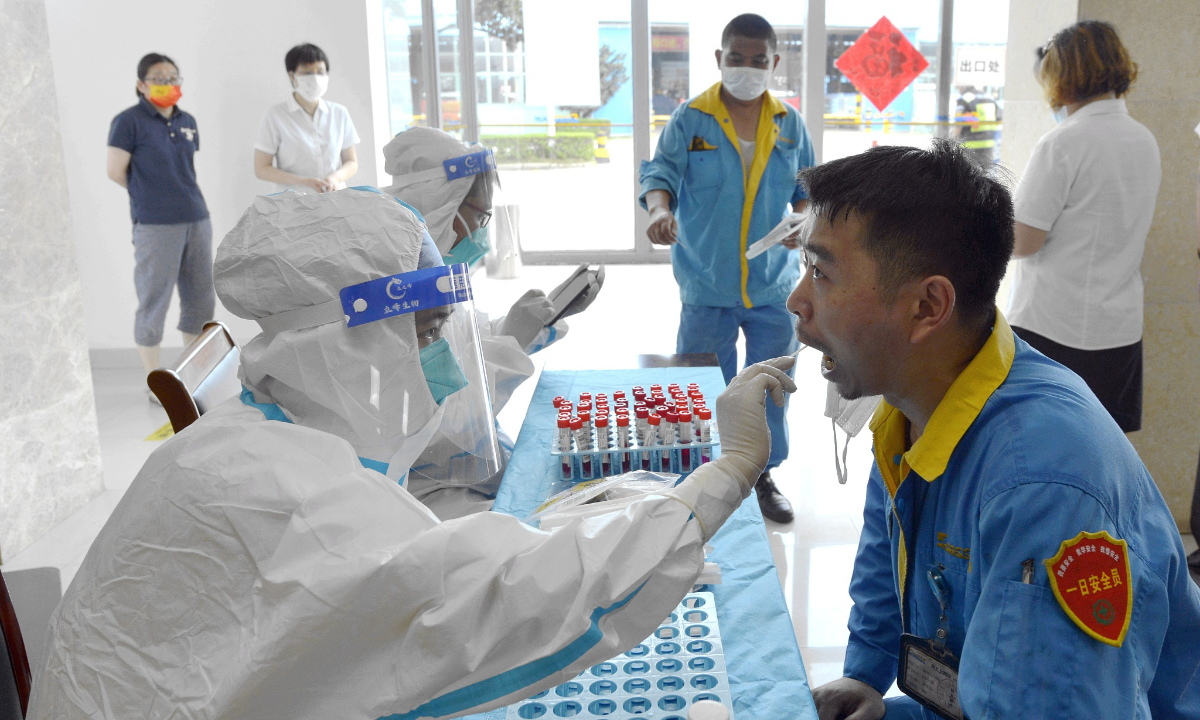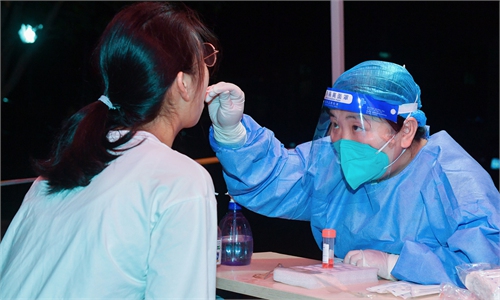Multiple Chinese cities tighten anti-epidemic measures as nearly 200 new COVID infections are found in a day across China

A medical worker takes a swab sample from a resident in Wuxi, East China's Jiangsu Province, on July 1. Photo: VCG
Chinese mainland found 183 local COVID-19 cases on Friday, including 38 confirmed and 145 asymptomatic cases. Daily cases on Friday expanded from the previous day, when the number of cases exceeded the 100 mark for the first time in 15 days. At least three cities have tightened their anti-epidemic measures including restricting personnel flows, however, experts said this round of burgeoning outbreak is limited in scale and could be quickly put under control.
East China's Anhui Province reported the largest number of infections, 34 confirmed and 101 asymptomatic cases, on Friday.
On the early morning of Saturday, the local COVID-19 prevention and control emergency headquarters in Sixian county, Suzhou, Anhui Province, issued a notice upgrading over 40 areas to either high or medium risk. The county also launched a new round of nucleic acid testing.
Among the positive cases found on Friday, 74 were found among quarantined personnel and 60 were found during nucleic acid testing in high- or medium-risk areas.
Previously on June 26, the county reported one silent COVID-19 carrier, and two more positive cases were found during the screening of the silent carrier's close contacts.
At the same time, infections in Sixian had already spread across Anhui and East China's Jiangsu Province, including nearby Lingbi county, Guzhen county, Huai 'an city and Xuzhou, as well as Nanjing and Wuxi.
Lingbi, another county in Suzhou, issued a notice on Friday requesting all the residents in the county remain at home, after three people tested positive were found to have travel history in Sixian.
All front-line personnel in Lingbi, including those in charge of epidemic prevention in government organs and public institutions, are prohibited from returning home, and are requested to eat and live in their work units to prevent more infections, according to the notice.
An immunologist, who requested anonymity, told the Global Times on Saturday this wave of the epidemic, centered in Suzhou, Anhui, is a small-scale outbreak at the moment, but warned the epidemic is likely to further spread to other areas. However, the expert believes this round of epidemic is unlikely to develop into a nationwide outbreak under the current efficient dynamic zero-COVID policy.
The expert urged the relevant departments to find the source of this outbreak as soon as possible.
Also on early Saturday morning, Wuxi in Jiangsu, which has found infections related to the Anhui outbreak, announced that there had been 39 new positive cases found in the city on Friday, and that environmental disinfection has been undertaken. Local residents are not allowed to leave the city unless necessary.
Inter-city bus services in Wuxi have been suspended on Saturday, and multiple tourist spots will also be closed for three days.
Yancheng, another city in Jiangsu, issued a notice early Saturday morning that an individual from Wuxi tested positive on Friday. The city urged residents who had recently travelled to either Wuxi or Sixian to report to officials.
East China's Zhejiang Province identified three positive cases - two in Hangzhou, and one in Jinhua - on Friday. Among them, one case was identified at a centralized quarantine site, and two from routine testing sites in residential communities.
East China's Shandong Province and Northeast China's Liaoning Province recorded four cases and eight infected cases, respectively, on Friday.
As of June 30, Huangdao district of Qingdao, Shandong, reported one confirmed case and 12 asymptomatic infections. The gene sequencing results showed that all infections were linked to the Omicron's BA.2 mutation found within contaminated samples from imported cold chain products, according to Qingdao's health authority.
Health authorities in Qingdao confirmed that the genetic sequencing results of this outbreak in Qingdao indicated that the infection was caused by contact with imported cold chain goods contaminated with the virus. The suspected shipment of imported cold chain goods has been sealed off, health officials said.
The expert group concluded that the overall risk of the epidemic in Qingdao is under control, and the risk of social transmission is basically eliminated, according to the local press conference on Saturday.
The latest resurgence led some to question if the rebound will force officials to adjust anti-epidemic measures to be "stricter," just days after the country shortened quarantine for close contacts and removed an asterisk for high-risk travelers in the country's travel history checking system.
Health experts reached by the Global Times believed that occasional flare-ups are inevitable as long as coronavirus exists, and that there are no signs the current round was caused by recent anti-epidemic policy adjustments. As long as the country's dynamic zero-COVID policy is well implemented, regionalized COVID-19 rebounds should be contained quickly and a broad scale outbreak remains unlikely, they said.


